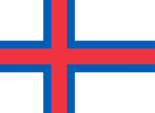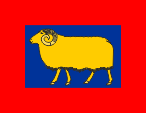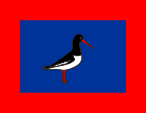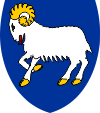Färöer |
|
|
|
| Übersicht – Contents: | |
Diese Seite ist Teil des Projektes
Färöer |
|
|
|
| Übersicht – Contents: | |
Flagge – Flag: |
|
 |
Flagge von Färöer – flag of Faroe Islands, |
historische Flaggen – historical Flags: |
|
 |
19. Jhd./19th century, |
 |
19. Jhd./19th cent.– ca. 1931, |
Bedeutung/Ursprung der Flagge – Meaning/Origin of the Flag: |
|
| Die
heutige Flagge der Färöer-Inseln wurde im Juni 1919 von färöischen Studenten
in Kopenhagen entworfen, und am 22. Juni 1919 inoffiziell im Ort Fámjin
gehisst. Das Design leitet sich aus der Flagge Norwegens ab und zeigt das typische skandinavische Kreuz, jedoch sind die Farben vertauscht. Seit 1959 wird das Blau etwas heller dargestellt, und seit dem 29.12.1998 sind die Farben exakt festgelegt. Als Farben für die Flagge werden angegeben: Rot = pt 032, Blau = pt 300. |
The today 's flag of the Faroe Islands
was designed in June 1919 by Faroese students in Copenhagen, and it was
unofficially hoisted on 22nd of June in 1919 in the village of Fámjin. The
design is derived from the flag of Norway and shows the typical Scandinavian
cross, but the colors are reversed. Since 1959 the blue is displayed slightly lighter, and since 29th of December in 1998 the colors are exactly defined. The colours, are given for the flag: red = pt 032, blue = pt 300. |
| Am 29.07.1930 wurde die heutige Flagge der Färöer anstelle der dänischen Flagge auf dem Färöischen Parlament gehisst, was nicht anerkannt wurde. Jedoch wurde die Verwendung der Flagge ab 1931 allgemein üblich, jedoch nicht amtlich. Sie wurde erst am 25.04.1940 offiziell eingeführt, um die Schiffe der nicht durch deutsche Truppen besetzten dänischen Inseln eindeutig zu kennzeichnen. Mit dem Autonomiegesetz vom 23.03.1948 wurde die Flagge der Färöer amtlich bestätigt. | On 29th of July in 1930 the today's flag of the Faroe Islands was hoisted instead of the Danish flag on the Faroese Parliament, which was not recognized. However, the use of the flag became a common practice from 1931, but not officially. The flag was officially introduced on 25th of April in 1940 to mark the vessels of the by German troops non-occupied Danish islands. The Autonomy Act of 23rd of March in 1948 confirmed the Flag of the Faroe Islands officially. |
| Im 19. Jahrhundert hat es noch einige andere inoffizielle Flaggen auf den Inseln gegeben, deren Schaffung mit dem aufkommenden Nationalbewusstsein zusammenhing. Zunächst wurde das Wappentier, ein Widder, auf ein blaues Feld in einer rotumrandeten Flagge platziert, später wurde der färöische Nationalvogel Tjaldur (Austernfischer) in das blaue Feld gesetzt. Mit dem Aufkommen der Kreuzflagge kamen diese Entwürfe außer Gebrauch. |
In the 19th century there had been some other unofficial flags on the
islands, whose creation was connected with the rise of national
consciousness. First, the animal from the coat of arms – an aries – was
placed on a blue field in a red-bordered flag, later the Faroese national
bird Tjaldur (Oystercatcher) was placed into the blue field. With the
appearance of the cross flag these designs came into disuse. |
| Quelle/Source: Wikipedia (D), Flags of the World | |
Wappen – Coat of Arms: |
|
 |
Wappen von Färöer – coat of arms of Faroe Islands Quelle/Source: nach/by: Wikipedia (D) |
Bedeutung/Ursprung des Wappens – Meaning/Origin of the Coat of Arms: |
|
| Der Widder gilt seit dem 14. Jahrhundert als das Wappentier der Färöer-Inseln. Als solches wurde er seit 1819 im großen Wappen von Dänemark verwendet, und zwar in Silber auf einem blauen Feld. Der Widder ist ein deutlicher Hinweis auf den Namen der Inselgruppe: Føroyar = Schafsinseln. Ein Wappen mit einem Widder wurde bis 1816 auf den Inseln vom Inselparlament (Løgting) amtlich verwendet, jedoch wurde das Løgting abgeschafft. Nach dem Inkrafttreten des Autonomiegesetzes von 1948 wurde der Widder durch den Premierminister der Färöer als Wappenzeichen im Jahre 1950 wieder eingeführt, und zwar in einem Siegel. Im Jahre 2004 wurde dann das heutige Wappen eingeführt. | The aries
is known since the 14th century as the emblem of the Faroe Islands. As such,
it was used in the greater coat of arms of Denmark since 1819, in silver on
a blue field. The aries is a clear indication for the name of the
archipelago: Føroyar = Sheep Islands.
A coat of arms with an aries was officially used until 1816 on the islands by the parliament of the archipelago (Løgting), but the Løgting was abolished. After the introduction of the Autonomy Law of 1948, the aries was re-introduced as the emblem of the Faroe Islands by the Prime Minister in 1950, but within a seal. In 2004 the today's coat of arms was introduced. |
| Quelle/Source: Wikipedia (D) | |
| Landkarte – Map: |
|
Landkarte des Landes – Map of the Country: |
|
|
Zahlen und Fakten – Numbers and Facts: |
|
|
|
|
|
|
|
|
|
|
|
|
|
|
|
|
|
|
|
|
Geschichte: |
|
9. Jhd. · beginnende norwegische Besiedlung 1380 · Färöer wird von Dänemark und Norwegen verwaltet 1814 · Färöer wird von Dänemark verwaltet 1940–1945 · britische Besetzung 1946 · einseitige Erklärung der politischen Unabhängigkeit 1948 · Gewährung innerer Selbstverwaltung |
History: |
|
9th century · beginning Norwegian settlement 1380 · Faroe is administrated by Denmark and Norway 1814 · Faroe is administrated by Denmark 1940–1945 · British occupation 1946 · unilateral declaration of the political independence 1948 · conceding of innerer self administration |
| Quelle/Source: Atlas zur Geschichte, Discovery '97 |
Ursprung des Landesnamens – Origin of the Country's Name: |
|
| Der Name
der Inselgruppe geht auf das dänische Wort für Schaf zurück: "Får". So sind die Färöer die "Schafinseln". |
The name of the archipelago goes back to the Danish word for sheep: "Får". So the Faroe Islands are the "sheep islands". |
| Quelle/Source: Wikipedia (D) | |